Sketch Archive
0 likes27 views
Here is a sketch arcive of some of my sketches from semester one.
1 of 14
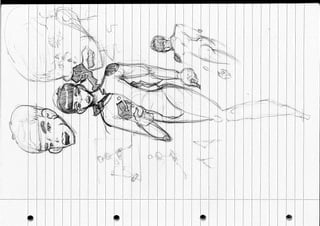
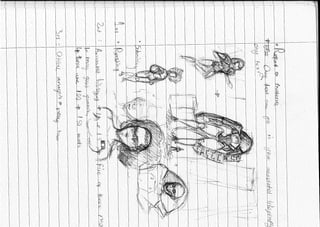
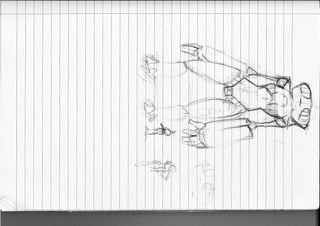

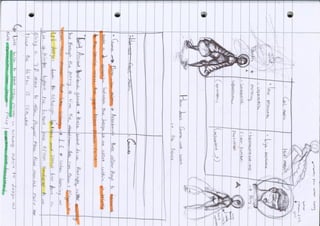
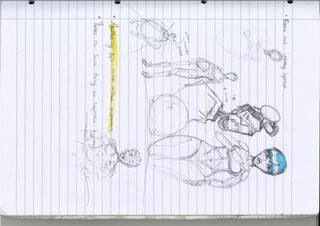
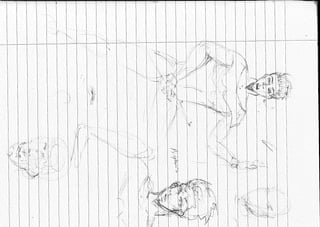
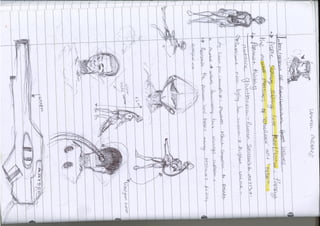
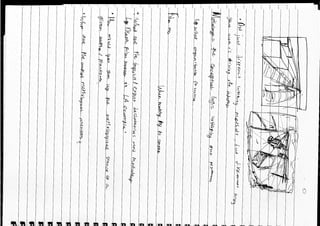
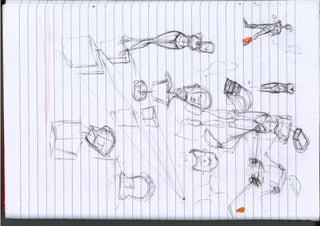
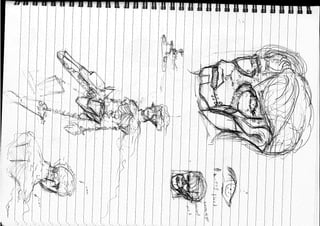
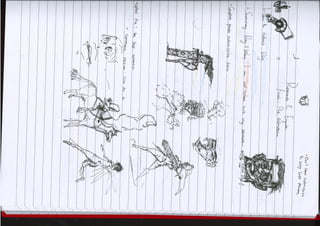

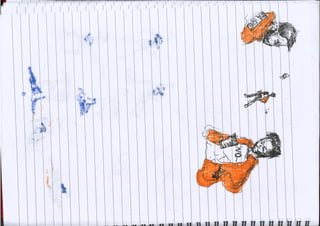
Ad
Recommended
Planetary composition - GDD
Planetary composition - GDD Ochuko Ideh
?
Players must fling asteroids at planetoids to build up their mass and composition in order to create planets. Asteroids come in different shapes, sizes, and mineral compositions of carbon, ice, water, iron, nickel, and metal. The minerals in an asteroid determine what type of planet is created. Planetoids act as the core for planets and have initial zero composition values that increase as asteroids are flung into them. Different mineral combinations result in planet types like rocky, icy, water, or metallic worlds.Blog usability testing
Blog usability testingOchuko Ideh
?
The document outlines a usability testing project for a blog, asking participants to evaluate various aspects of the blog on a scale of 1 to 10. Key questions focus on the identifiability of blog labels, archives, and overall navigation ease. Participants must also sign a consent agreement to participate.Lock and Key Design Document Draft Two
Lock and Key Design Document Draft Two Ochuko Ideh
?
The document outlines a design document for a final project called "Lock and Key". The game will utilize motion controls for puzzle solving and collaboration between 2 players. It will have an isometric view and feature collectibles. The game is targeted towards ages 5-10 and will teach mechanics over 3 worlds with increasing difficulty. It emphasizes fun, curiosity and wonder through its progression structure and use of motion controls.Lock And Key Initial Design Document
Lock And Key Initial Design DocumentOchuko Ideh
?
The document describes a proposed final project called Lock and Key, a motion-controlled puzzle game for the Nintendo Wii. Players must collaborate to solve puzzles, clear levels, and collect broken pieces of their home ship to escape an alien world. The game aims to provide "easy" and "serious" fun through curiosity, wonder, surprise, awe, focus, excitement, and relaxation. It will utilize intuitive motion controls like Wii Sports and Elebits. Players will progress through a three-act structure with worlds containing three levels each to introduce new mechanics and allow players to learn, practice, and master skills through collaboration.Full Unity Cloud Build Log of the 'Gachapoint' Demo
Full Unity Cloud Build Log of the 'Gachapoint' Demo Ochuko Ideh
?
The document describes the log output from building a Unity project for the Android platform. It shows the project being checked out from source control, dependencies being resolved, Unity being initialized and switching to the Android target platform, and the project building and compiling in Unity.Final project preproposal
Final project preproposalOchuko Ideh
?
The document outlines a final project proposal for a mobile game that gamifies exercise using collecting and battling mechanics, designed for the Android platform. The game will utilize a functional open source pedometer and feature an in-game currency system based on user steps, with strict adherence to design standards and project milestones. The proposal also emphasizes the skills and technical knowledge needed for a career as a technical game designer, along with a job search plan targeting relevant employment opportunities.Story board order
Story board order Ochuko Ideh
?
The document provides a 16-item shooting order for a teaser trailer. It lists scenes that will be filmed, including a character looking out a window, a car pulling into a driveway, establishing shots of a house, a confrontation with the mother, scenes in the bathroom, a child being bullied while doing homework, the mother praying and the child crying over a bible, walking home from school, an imaginary car accident, the mother leaving the house, torment with the power out, blood on the child's face, and increasing speed with Lucy.My ShOoting order
My ShOoting orderOchuko Ideh
?
This document provides a shooting order for filming scenes over four days - mornings, midday, dawn, and night - for a teaser trailer. The morning shots include a character looking out a window and a car pulling up. The afternoon shots consist of establishing shots of a house and bullying during homework. Dawn shots show walking home from school and being hit by an imaginary car. Night shots include a mother confrontation, bathroom scenes, power outages, and blood on the character's face.Japanese horror films
Japanese horror films Ochuko Ideh
?
Japanese horror films, known as J horror, have become hugely popular globally since their inception. J horrors tend to feature psychological horror, building suspense and tension. Many contain themes of Japanese folk religion like possession and exorcism. The origins of J horror can be traced back to traditional ghost stories from the Edo and Meiji periods of Japanese history known as Kaidan. Elements of these ancient Japanese ghost stories are still featured in modern J horror films today.Horror movie focus group transcript
Horror movie focus group transcript Ochuko Ideh
?
The document is a transcript from a focus group discussion about horror movies. Participants were asked about their favorite horror films, qualities they look for in trailers, preferences around protagonists and story settings, and advice for creating an effective horror movie trailer. Common responses included a preference for psychological thrillers, the importance of music, using fading effects between scenes, and keeping trailers fast-paced with many short clips and jump cuts.Letter of consent
Letter of consent Ochuko Ideh
?
This document outlines the consent form for a focus group being conducted for an A2 Media Studies course. It states that the purpose is to gather information to help cater the coursework to a chosen demographic. It notes that participation is voluntary and can be stopped at any time, responses will remain anonymous, and that various viewpoints are wanted from everyone even if they disagree with others. It asks for one person to speak at a time and for responses to remain confidential.Focus group participant demographic
Focus group participant demographic Ochuko Ideh
?
This document contains a demographic survey for a focus group discussing horror movies. It asks for the participant's gender and age. It also asks the participant to identify their favorite horror movie subgenre and to explain their choice. Finally, it asks questions about what they find scariest in horror movies, whether they prefer a male or female protagonist, common horror movie settings, when a horror movie should be set, and what makes a scary horror movie trailer.Horror movie focus group powerpoint
Horror movie focus group powerpointOchuko Ideh
?
This document outlines 7 questions for a focus group discussion on horror movies, asking about participants' favorite films and trailers, opinions on films with female protagonists and true stories, and time periods films are set in. The final question invites any additional advice on horror movie trailers.Audience research questionnaire
Audience research questionnaire Ochuko Ideh
?
This document contains a 10 question survey to gather information from audiences about their preferences for horror movies. It asks about demographics, favorite horror subgenres, what they find scariest, preferred protagonist gender, expected settings, time periods, and what makes a scary trailer. Respondents are asked to select answers and provide explanations for some questions.My target Audience
My target AudienceOchuko Ideh
?
This document discusses the target audience for a horror film trailer. The target audience is teenagers and young adults aged 15-25, as they are more open to exploring new things and thrill-seeking. Males are most likely to be fans of horror due to the violence and gore, though efforts could be made to attract more females by including a female protagonist or less graphic violence. The target class is working class and above, as horror films provide cheap entertainment, and portraying protagonists from working or higher classes fosters reliability and empathy.As media studies evaluation music magazine
As media studies evaluation music magazine Ochuko Ideh
?
The document discusses the media student's alternative music magazine project and how it utilizes and develops conventions of real music magazines. Some key points:
- The magazine uses conventions like mastheads, left thirds, and coverlines to promote stories but challenges conventions through the placement and design of these elements.
- The content page includes images, pull quotes, and a subscription box like real magazines. One image is submerged to draw attention.
- A double page story uses different fonts, pull quotes, drop caps, and photo credits like in real magazines.
- While mostly following conventions, the student aimed to add some uniqueness through small details like the barcode placement, to reflect the magazine's alternative genre.Media music magazine traditional questionnaire
Media music magazine traditional questionnaireOchuko Ideh
?
The document discusses representation of alternative rappers in media and music magazines. It presents a questionnaire that asks questions about whether the alternative rap scene is predominantly male, if more coverage of female artists is needed in alternative magazines, if different ethnic groups are represented, and if alternative rappers are portrayed negatively in the media. The questionnaire is aimed at gathering opinions on diversity and representation within the alternative rap genre.A$AP ROCKY star Image, Ochuko
A$AP ROCKY star Image, OchukoOchuko Ideh
?
A$AP Rocky has established his star image through his hair style and gold grills in his teeth, motifs that have been adopted by other rappers. He has also incorporated the American flag and patriotic symbols into his image, possibly to convey a sense of regional identity as he develops his unique musical style.Tyler the creator
Tyler the creatorOchuko Ideh
?
Tyler the Creator has a strong fashion sense that his record label incorporated into his star image to help fans relate to him. They optimized this by basing his style on popular teen clothing brands and having him release his own clothing line imitating styles of brands like Supreme and CDG. For a photoshoot, the document's author decided to base their star image on Tyler's to attract both male and female alternative rap fans by replicating Tyler's representation and characteristics, including creating their own clothing brand for their star image.Azelia banks
Azelia banksOchuko Ideh
?
Azelia Banks has developed a distinctive star image centered around her colorful, unique hairstyles which are never worn twice. Her dress sense is described as "Blister (black hipster) chic or Nerd couture." The document discusses imitating Azelia Banks' star image, including look, personality and presentation, for a photo shoot cover.Star image By Ochuko Ideh
Star image By Ochuko IdehOchuko Ideh
?
Star image is a universally recognized style or look that a star uses across different media platforms to build their brand. According to Richard Dyers' Star Theory, a star is an artificial image constructed from various materials to appeal to audiences. Record companies purposefully craft stars' images to appeal to certain demographics in order to generate revenue. Star image motifs, like recurring images or outfits, are used to further establish stars as brands and make them easily recognizable to the public.My masthead by Ochuko
My masthead by OchukoOchuko Ideh
?
Ochuko designed a magazine masthead drawing inspiration from both the simplistic style of Spin magazine and the bold style of NME magazine. They provided a vague sketch of what their masthead may look like. They then explained that they based their masthead on Spin magazine, using the word "indie" as a possible magazine title to represent its alternative theme. Ochuko chose not to use capital letters to emphasize the magazine's alternative nature and used the Swatch font created by the watch company for its logo.Court_Film_Presentation and the represtaion
Court_Film_Presentation and the represtaionNaveenLV3
?
this is about the presentaion of the movie court in the film about caseMore Than a Moodboard: The Macro Trends Behind the Next Fashion Wave
More Than a Moodboard: The Macro Trends Behind the Next Fashion Waveglobalbookmarketinga
?
In an industry known for its constant churn, it’s easy to mistake trends for passing moments — a pattern here, a silhouette there. But the most impactful trends don’t just change wardrobes; they reflect shifts in culture, identity, technology, and the way we live. These are macro trends — deep-rooted, slow-burning movements that shape not just what we wear, but why we wear it.
This distinction is precisely what makes the latest special edition of Exclusive Fashion Magazine (EFM) so vital. Curated under the visionary leadership of Jason Weldon, the 600+ page issue is more than a visual feast. It’s a cultural artifact — capturing the undercurrents that are pushing fashion into new, uncharted territory. From global artistry to sustainability redefined, EFM positions itself not only as a chronicler of trend cycles but a shaper of them.
So, what exactly are the macro trends shaping the next wave of fashion? Here’s what’s rising — and what EFM is boldly amplifying.
1. Cultural Hybridity as Creative Engine
Gone are the days when fashion was dominated by a Eurocentric lens. Today’s most exciting designers are blending cultural references into wholly new design languages — not as token gestures, but as authentic expressions of identity. From South Asian silhouettes rendered in modern mesh to Indigenous beadwork layered over techwear, fashion is becoming a site of cultural reclamation and hybridity.
EFM’s special issue puts this front and center, featuring emerging designers from regions often overlooked in the global conversation. Each collection isn’t just wearable art — it’s a dialogue between ancestry and aspiration. Jason Weldon’s editorial direction ensures these voices aren’t diluted but celebrated, showing how cultural fluidity is now a key driver of creative innovation.
2. The Rise of Purpose-Led Fashion
Consumers are no longer satisfied with style for style’s sake. They want to know what their clothes stand for — who made them, how they were sourced, and what values they represent. As a result, fashion is becoming increasingly aligned with social and environmental purpose.
Whether it’s a designer using biodegradable materials or a brand supporting community-led supply chains, purpose is now inseparable from product. EFM doesn’t just cover these efforts as trends — it treats them as industry imperatives. In this edition, readers are introduced to changemakers who see fashion as a platform for climate justice, ethical labor, and cultural preservation. This is fashion with a mission, and EFM is giving it the spotlight it deserves.最新版美国威斯康星大学苏必利尔分校毕业证(鲍奥厂毕业证书)原版定制
最新版美国威斯康星大学苏必利尔分校毕业证(鲍奥厂毕业证书)原版定制Taqyea
?
鉴于此,定制威斯康星大学苏必利尔分校学位证书提升履历【q薇1954292140】原版高仿威斯康星大学苏必利尔分校毕业证(UWS毕业证书)可先看成品样本【q薇1954292140】帮您解决在美国威斯康星大学苏必利尔分校未毕业难题,美国毕业证购买,美国文凭购买,【q微1954292140】美国文凭购买,美国文凭定制,美国文凭补办。专业在线定制美国大学文凭,定做美国本科文凭,【q微1954292140】复制美国University of Wisconsin-Superior completion letter。在线快速补办美国本科毕业证、硕士文凭证书,购买美国学位证、威斯康星大学苏必利尔分校Offer,美国大学文凭在线购买。
如果您处于以下几种情况:
◇在校期间,因各种原因未能顺利毕业……拿不到官方毕业证
◇面对父母的压力,希望尽快拿到;
◇不清楚认证流程以及材料该如何准备;
◇回国时间很长,忘记办理;
◇回国马上就要找工作,办给用人单位看;
◇企事业单位必须要求办理的
◇需要报考公务员、购买免税车、落转户口
◇申请留学生创业基金
【复刻一套威斯康星大学苏必利尔分校毕业证成绩单信封等材料最强攻略,Buy University of Wisconsin-Superior Transcripts】
购买日韩成绩单、英国大学成绩单、美国大学成绩单、澳洲大学成绩单、加拿大大学成绩单(q微1954292140)新加坡大学成绩单、新西兰大学成绩单、爱尔兰成绩单、西班牙成绩单、德国成绩单。成绩单的意义主要体现在证明学习能力、评估学术背景、展示综合素质、提高录取率,以及是作为留信认证申请材料的一部分。
威斯康星大学苏必利尔分校成绩单能够体现您的的学习能力,包括威斯康星大学苏必利尔分校课程成绩、专业能力、研究能力。(q微1954292140)具体来说,成绩报告单通常包含学生的学习技能与习惯、各科成绩以及老师评语等部分,因此,成绩单不仅是学生学术能力的证明,也是评估学生是否适合某个教育项目的重要依据!windfarmnoise-vandehei.ppteeeeeeeeeeeeeeeeeeeee
windfarmnoise-vandehei.ppteeeeeeeeeeeeeeeeeeeeeAhaf5
?
eeeeeeeeeeeeeeeeeeeeeeeeeeeeeeeeeeeeeeeeeeeeeeeeeeeeeeeeeeeeeeeeeeeeeeeeeeeeeeeeeeeeeeeeeeeeeeeeeeeeeeeeeeeeeeeeeeeeeeeMore Related Content
More from Ochuko Ideh (14)
Japanese horror films
Japanese horror films Ochuko Ideh
?
Japanese horror films, known as J horror, have become hugely popular globally since their inception. J horrors tend to feature psychological horror, building suspense and tension. Many contain themes of Japanese folk religion like possession and exorcism. The origins of J horror can be traced back to traditional ghost stories from the Edo and Meiji periods of Japanese history known as Kaidan. Elements of these ancient Japanese ghost stories are still featured in modern J horror films today.Horror movie focus group transcript
Horror movie focus group transcript Ochuko Ideh
?
The document is a transcript from a focus group discussion about horror movies. Participants were asked about their favorite horror films, qualities they look for in trailers, preferences around protagonists and story settings, and advice for creating an effective horror movie trailer. Common responses included a preference for psychological thrillers, the importance of music, using fading effects between scenes, and keeping trailers fast-paced with many short clips and jump cuts.Letter of consent
Letter of consent Ochuko Ideh
?
This document outlines the consent form for a focus group being conducted for an A2 Media Studies course. It states that the purpose is to gather information to help cater the coursework to a chosen demographic. It notes that participation is voluntary and can be stopped at any time, responses will remain anonymous, and that various viewpoints are wanted from everyone even if they disagree with others. It asks for one person to speak at a time and for responses to remain confidential.Focus group participant demographic
Focus group participant demographic Ochuko Ideh
?
This document contains a demographic survey for a focus group discussing horror movies. It asks for the participant's gender and age. It also asks the participant to identify their favorite horror movie subgenre and to explain their choice. Finally, it asks questions about what they find scariest in horror movies, whether they prefer a male or female protagonist, common horror movie settings, when a horror movie should be set, and what makes a scary horror movie trailer.Horror movie focus group powerpoint
Horror movie focus group powerpointOchuko Ideh
?
This document outlines 7 questions for a focus group discussion on horror movies, asking about participants' favorite films and trailers, opinions on films with female protagonists and true stories, and time periods films are set in. The final question invites any additional advice on horror movie trailers.Audience research questionnaire
Audience research questionnaire Ochuko Ideh
?
This document contains a 10 question survey to gather information from audiences about their preferences for horror movies. It asks about demographics, favorite horror subgenres, what they find scariest, preferred protagonist gender, expected settings, time periods, and what makes a scary trailer. Respondents are asked to select answers and provide explanations for some questions.My target Audience
My target AudienceOchuko Ideh
?
This document discusses the target audience for a horror film trailer. The target audience is teenagers and young adults aged 15-25, as they are more open to exploring new things and thrill-seeking. Males are most likely to be fans of horror due to the violence and gore, though efforts could be made to attract more females by including a female protagonist or less graphic violence. The target class is working class and above, as horror films provide cheap entertainment, and portraying protagonists from working or higher classes fosters reliability and empathy.As media studies evaluation music magazine
As media studies evaluation music magazine Ochuko Ideh
?
The document discusses the media student's alternative music magazine project and how it utilizes and develops conventions of real music magazines. Some key points:
- The magazine uses conventions like mastheads, left thirds, and coverlines to promote stories but challenges conventions through the placement and design of these elements.
- The content page includes images, pull quotes, and a subscription box like real magazines. One image is submerged to draw attention.
- A double page story uses different fonts, pull quotes, drop caps, and photo credits like in real magazines.
- While mostly following conventions, the student aimed to add some uniqueness through small details like the barcode placement, to reflect the magazine's alternative genre.Media music magazine traditional questionnaire
Media music magazine traditional questionnaireOchuko Ideh
?
The document discusses representation of alternative rappers in media and music magazines. It presents a questionnaire that asks questions about whether the alternative rap scene is predominantly male, if more coverage of female artists is needed in alternative magazines, if different ethnic groups are represented, and if alternative rappers are portrayed negatively in the media. The questionnaire is aimed at gathering opinions on diversity and representation within the alternative rap genre.A$AP ROCKY star Image, Ochuko
A$AP ROCKY star Image, OchukoOchuko Ideh
?
A$AP Rocky has established his star image through his hair style and gold grills in his teeth, motifs that have been adopted by other rappers. He has also incorporated the American flag and patriotic symbols into his image, possibly to convey a sense of regional identity as he develops his unique musical style.Tyler the creator
Tyler the creatorOchuko Ideh
?
Tyler the Creator has a strong fashion sense that his record label incorporated into his star image to help fans relate to him. They optimized this by basing his style on popular teen clothing brands and having him release his own clothing line imitating styles of brands like Supreme and CDG. For a photoshoot, the document's author decided to base their star image on Tyler's to attract both male and female alternative rap fans by replicating Tyler's representation and characteristics, including creating their own clothing brand for their star image.Azelia banks
Azelia banksOchuko Ideh
?
Azelia Banks has developed a distinctive star image centered around her colorful, unique hairstyles which are never worn twice. Her dress sense is described as "Blister (black hipster) chic or Nerd couture." The document discusses imitating Azelia Banks' star image, including look, personality and presentation, for a photo shoot cover.Star image By Ochuko Ideh
Star image By Ochuko IdehOchuko Ideh
?
Star image is a universally recognized style or look that a star uses across different media platforms to build their brand. According to Richard Dyers' Star Theory, a star is an artificial image constructed from various materials to appeal to audiences. Record companies purposefully craft stars' images to appeal to certain demographics in order to generate revenue. Star image motifs, like recurring images or outfits, are used to further establish stars as brands and make them easily recognizable to the public.My masthead by Ochuko
My masthead by OchukoOchuko Ideh
?
Ochuko designed a magazine masthead drawing inspiration from both the simplistic style of Spin magazine and the bold style of NME magazine. They provided a vague sketch of what their masthead may look like. They then explained that they based their masthead on Spin magazine, using the word "indie" as a possible magazine title to represent its alternative theme. Ochuko chose not to use capital letters to emphasize the magazine's alternative nature and used the Swatch font created by the watch company for its logo.Recently uploaded (20)
Court_Film_Presentation and the represtaion
Court_Film_Presentation and the represtaionNaveenLV3
?
this is about the presentaion of the movie court in the film about caseMore Than a Moodboard: The Macro Trends Behind the Next Fashion Wave
More Than a Moodboard: The Macro Trends Behind the Next Fashion Waveglobalbookmarketinga
?
In an industry known for its constant churn, it’s easy to mistake trends for passing moments — a pattern here, a silhouette there. But the most impactful trends don’t just change wardrobes; they reflect shifts in culture, identity, technology, and the way we live. These are macro trends — deep-rooted, slow-burning movements that shape not just what we wear, but why we wear it.
This distinction is precisely what makes the latest special edition of Exclusive Fashion Magazine (EFM) so vital. Curated under the visionary leadership of Jason Weldon, the 600+ page issue is more than a visual feast. It’s a cultural artifact — capturing the undercurrents that are pushing fashion into new, uncharted territory. From global artistry to sustainability redefined, EFM positions itself not only as a chronicler of trend cycles but a shaper of them.
So, what exactly are the macro trends shaping the next wave of fashion? Here’s what’s rising — and what EFM is boldly amplifying.
1. Cultural Hybridity as Creative Engine
Gone are the days when fashion was dominated by a Eurocentric lens. Today’s most exciting designers are blending cultural references into wholly new design languages — not as token gestures, but as authentic expressions of identity. From South Asian silhouettes rendered in modern mesh to Indigenous beadwork layered over techwear, fashion is becoming a site of cultural reclamation and hybridity.
EFM’s special issue puts this front and center, featuring emerging designers from regions often overlooked in the global conversation. Each collection isn’t just wearable art — it’s a dialogue between ancestry and aspiration. Jason Weldon’s editorial direction ensures these voices aren’t diluted but celebrated, showing how cultural fluidity is now a key driver of creative innovation.
2. The Rise of Purpose-Led Fashion
Consumers are no longer satisfied with style for style’s sake. They want to know what their clothes stand for — who made them, how they were sourced, and what values they represent. As a result, fashion is becoming increasingly aligned with social and environmental purpose.
Whether it’s a designer using biodegradable materials or a brand supporting community-led supply chains, purpose is now inseparable from product. EFM doesn’t just cover these efforts as trends — it treats them as industry imperatives. In this edition, readers are introduced to changemakers who see fashion as a platform for climate justice, ethical labor, and cultural preservation. This is fashion with a mission, and EFM is giving it the spotlight it deserves.最新版美国威斯康星大学苏必利尔分校毕业证(鲍奥厂毕业证书)原版定制
最新版美国威斯康星大学苏必利尔分校毕业证(鲍奥厂毕业证书)原版定制Taqyea
?
鉴于此,定制威斯康星大学苏必利尔分校学位证书提升履历【q薇1954292140】原版高仿威斯康星大学苏必利尔分校毕业证(UWS毕业证书)可先看成品样本【q薇1954292140】帮您解决在美国威斯康星大学苏必利尔分校未毕业难题,美国毕业证购买,美国文凭购买,【q微1954292140】美国文凭购买,美国文凭定制,美国文凭补办。专业在线定制美国大学文凭,定做美国本科文凭,【q微1954292140】复制美国University of Wisconsin-Superior completion letter。在线快速补办美国本科毕业证、硕士文凭证书,购买美国学位证、威斯康星大学苏必利尔分校Offer,美国大学文凭在线购买。
如果您处于以下几种情况:
◇在校期间,因各种原因未能顺利毕业……拿不到官方毕业证
◇面对父母的压力,希望尽快拿到;
◇不清楚认证流程以及材料该如何准备;
◇回国时间很长,忘记办理;
◇回国马上就要找工作,办给用人单位看;
◇企事业单位必须要求办理的
◇需要报考公务员、购买免税车、落转户口
◇申请留学生创业基金
【复刻一套威斯康星大学苏必利尔分校毕业证成绩单信封等材料最强攻略,Buy University of Wisconsin-Superior Transcripts】
购买日韩成绩单、英国大学成绩单、美国大学成绩单、澳洲大学成绩单、加拿大大学成绩单(q微1954292140)新加坡大学成绩单、新西兰大学成绩单、爱尔兰成绩单、西班牙成绩单、德国成绩单。成绩单的意义主要体现在证明学习能力、评估学术背景、展示综合素质、提高录取率,以及是作为留信认证申请材料的一部分。
威斯康星大学苏必利尔分校成绩单能够体现您的的学习能力,包括威斯康星大学苏必利尔分校课程成绩、专业能力、研究能力。(q微1954292140)具体来说,成绩报告单通常包含学生的学习技能与习惯、各科成绩以及老师评语等部分,因此,成绩单不仅是学生学术能力的证明,也是评估学生是否适合某个教育项目的重要依据!windfarmnoise-vandehei.ppteeeeeeeeeeeeeeeeeeeee
windfarmnoise-vandehei.ppteeeeeeeeeeeeeeeeeeeeeAhaf5
?
eeeeeeeeeeeeeeeeeeeeeeeeeeeeeeeeeeeeeeeeeeeeeeeeeeeeeeeeeeeeeeeeeeeeeeeeeeeeeeeeeeeeeeeeeeeeeeeeeeeeeeeeeeeeeeeeeeeeeeeI?NCI? EVI?NER RETROSPEKTI?FI?, RETROSPECTIVE (2).ppsx
I?NCI? EVI?NER RETROSPEKTI?FI?, RETROSPECTIVE (2).ppsx***
?
I?NCI? EVI?NER RETROSPEKTI?FI?, RETROSPECTIVE (2).ppsx最新版美国中佛罗里达大学毕业证(鲍颁贵毕业证书)原版定制
最新版美国中佛罗里达大学毕业证(鲍颁贵毕业证书)原版定制taqyea
?
2025原版中佛罗里达大学毕业证书pdf电子版【q薇1954292140】美国毕业证办理UCF中佛罗里达大学毕业证书多少钱?【q薇1954292140】海外各大学Diploma版本,因为疫情学校推迟发放证书、证书原件丢失补办、没有正常毕业未能认证学历面临就业提供解决办法。当遭遇挂科、旷课导致无法修满学分,或者直接被学校退学,最后无法毕业拿不到毕业证。此时的你一定手足无措,因为留学一场,没有获得毕业证以及学历证明肯定是无法给自己和父母一个交代的。
【复刻中佛罗里达大学成绩单信封,Buy University of Central Florida Transcripts】
购买日韩成绩单、英国大学成绩单、美国大学成绩单、澳洲大学成绩单、加拿大大学成绩单(q微1954292140)新加坡大学成绩单、新西兰大学成绩单、爱尔兰成绩单、西班牙成绩单、德国成绩单。成绩单的意义主要体现在证明学习能力、评估学术背景、展示综合素质、提高录取率,以及是作为留信认证申请材料的一部分。
中佛罗里达大学成绩单能够体现您的的学习能力,包括中佛罗里达大学课程成绩、专业能力、研究能力。(q微1954292140)具体来说,成绩报告单通常包含学生的学习技能与习惯、各科成绩以及老师评语等部分,因此,成绩单不仅是学生学术能力的证明,也是评估学生是否适合某个教育项目的重要依据!
我们承诺采用的是学校原版纸张(原版纸质、底色、纹路)我们工厂拥有全套进口原装设备,特殊工艺都是采用不同机器制作,仿真度基本可以达到100%,所有成品以及工艺效果都可提前给客户展示,不满意可以根据客户要求进行调整,直到满意为止!
【主营项目】
一、工作未确定,回国需先给父母、亲戚朋友看下文凭的情况,办理毕业证|办理文凭: 买大学毕业证|买大学文凭【q薇1954292140】中佛罗里达大学学位证明书如何办理申请?
二、回国进私企、外企、自己做生意的情况,这些单位是不查询毕业证真伪的,而且国内没有渠道去查询国外文凭的真假,也不需要提供真实教育部认证。鉴于此,办理美国成绩单中佛罗里达大学毕业证【q薇1954292140】国外大学毕业证, 文凭办理, 国外文凭办理, 留信网认证Indian_Constitution_Presentation_Final.pptx
Indian_Constitution_Presentation_Final.pptxjaglandushyant
?
The presentation includes:
Constitution overview
Dr. B. R. Ambedkar
Constituent Assembly
Preamble of the Constitution
Indian ParliamentEnergy_Storage_Study.pptxffffffffffffffffffffffffffffff
Energy_Storage_Study.pptxffffffffffffffffffffffffffffffAhaf5
?
tttttttttttttttttttttttttttttttttttttttttttttttttttttttttttttttttttttttttttttttttttttttttttttttttttttttttttttttttttttAd
